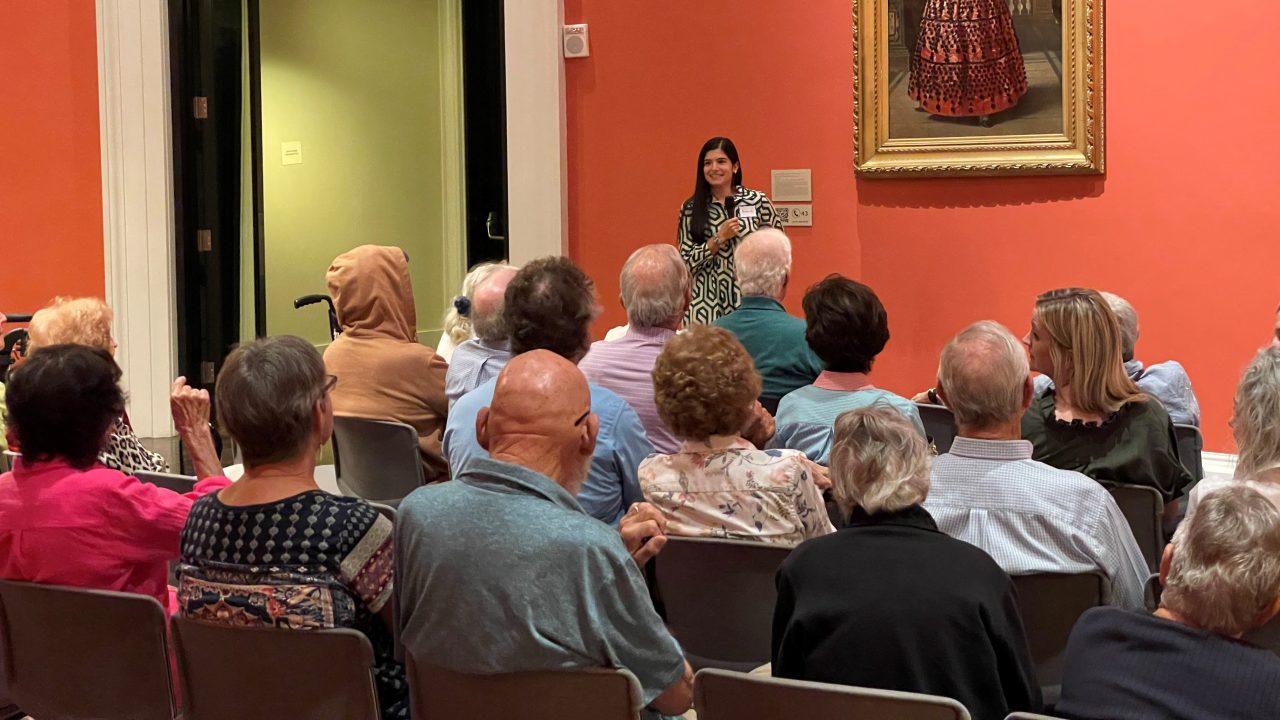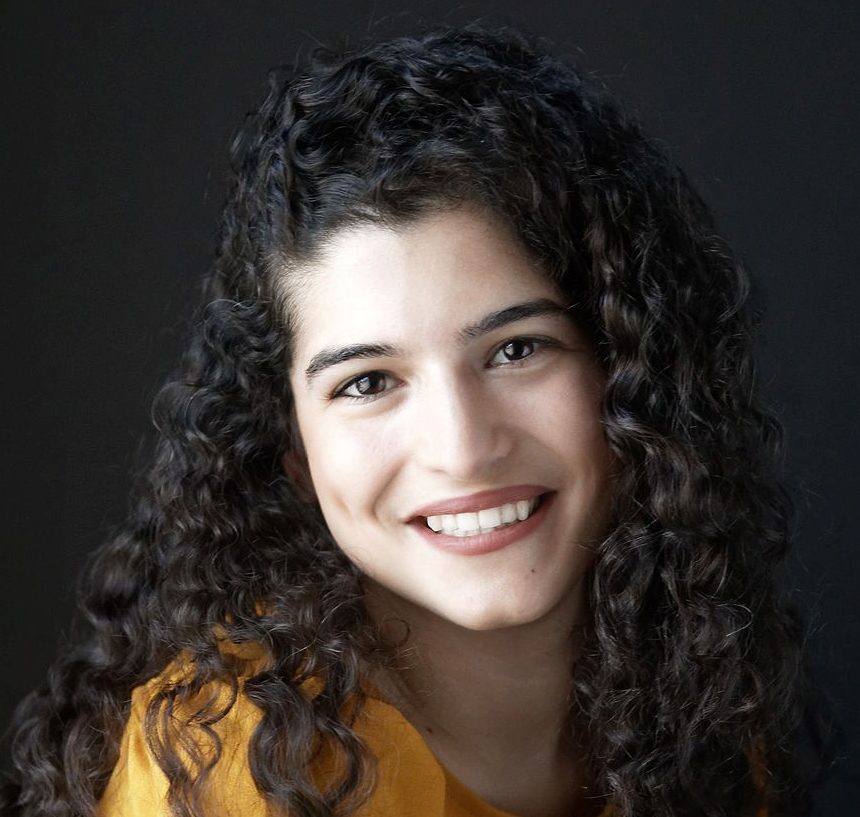
In the words of renowned museum educator and empathy expert Elif Gokcigdem, “Museums are safe, informal learning spaces, uniquely equipped to help audiences explore and imagine our human heritage and collective experiences.” Museum educational programming provides inclusive spaces where visitors can share their stories, listen to and learn from others, and pursue wonder and connection with individuals. As a museum educator for access programs, including memory care programs for people with Alzheimer’s or dementia, I have seen this potential in action firsthand. When executed well, memory care programs provide a safe space where people with memory loss can recount their experiences and share a communal bond with others.
In the Meadows Museum at SMU’s memory care program, Connections/Reconnections, we explore the themes of different works of art from the museum’s permanent collection through discussion and hands-on art activities. Over the past few months, we have engaged participants with dynamic activities like music therapy, cookie-decorating, painting with ceramic tiles, and even spending time with therapy dogs. Though I joined the program in 2021, the Connections/Reconnections community at the museum began over ten years ago, and I am grateful to have inherited such a robust program that has remained vital for its participants, even amidst the pandemic. I have not only learned many lessons about teaching and programming for this specific museum audience, but also felt embraced by the members of the group, who welcomed me as their new instructor with open arms.
While most major museums in the United States offer this kind of memory care programming already, the following guidelines present new ways in which educators can improve their practice and develop more empathetic and inclusive environments for audiences with memory loss at their institutions.
1. Cultivate Connections
The Connections/Reconnections program is specifically geared towards people with an early Alzheimer’s diagnosis and their care partners, and provides attendees with the gift of time and bonding with their loved one and other attendees through art-looking, discussions, and hands-on making activities. One of the ways we cultivate this community and connection is by establishing informal social time at the beginning of each program.
We begin each meeting seated in a big room with four tables and a catered continental breakfast. As participants come in, we encourage them to grab a name tag, sit down, and chat with one another while sipping a hot cup of coffee or tea. The museum docents are also an integral part of the program, as they sit and socialize with participants. Some have even developed lifelong friendships with them over the years. As an educator, I use this time to get to know each person individually. Who are they? What are their interests? How is their week going?
Taking this time to get to know each person on a relational level is an example of what art educators Morse and Munro call small, mundane acts of care. Engaging with participants in small talk, and making an effort to learn everyone’s names, brings a humanizing aspect to the program that centers the visitor and their experience, not necessarily the educator’s agenda or curriculum. It is also crucial that educators treat all participants with care and respect. At Connections/Reconnections, we do not ask participants to make distinctions between the care partner and the individual with the diagnosis. Every attendee is treated with dignity, listened to, and included in conversations and discussion.
2. Collaborate with Community Partners
One of the pleasures of working in museum education is getting to collaborate with other staff members to create dynamic public programs. Working alongside other educators and professionals allows us to extend our perspective and see things differently through opinions and ideas we may not have previously considered. This effect is even more pronounced when we seek collaboration opportunities with outside people and organizations. For example, Connections/Reconnections has a partnership with the Alzheimer’s Association which provides useful training for educators with a direct contact person from our local chapter. Partnering with the association not only gives us the tools to create and provide a better program for participants, but it also helps us reach more individuals who might benefit from the program and would not have thought to look for resources directly with the museum.
Collaboration with others outside the museum also ensures our program has diverse and interactive components that go beyond art appreciation and art-making. As a museum educator and former art student, I know firsthand that these activities can be intimidating—especially for people who are less experienced with them. Therefore, I am always looking for ways to integrate other elements like music, therapy dogs, and guest speakers into our programming. In the fall, for example, we started the season with a pet-friendly theme. Our activities included looking at works of art from the permanent collection that featured pugs along with a visit from volunteer therapy dogs. I have found that novel approaches like this, with the help of partners, can pique the interest of people who may be intimidated by traditional art museum program activities.
3. Be Vulnerable and Empathetic
In Connections/Reconnections, we begin each ninety-minute program with an overarching theme, which I introduce to the group by asking general questions, such as:
- “When was the last time you went on vacation?”
- “Do you have, or have you had, a pet that you love?”
Participants are generous with their responses, sometimes even sharing funny stories about trips they’ve taken with family members. They have even brought photographs of their long-gone loyal dogs to share with the rest of the group. During these moments of sharing and discussion, we laugh together, offer sympathy to one another’s experiences, and tell our own stories.
This portion of the program can often be as vulnerable and meaningful for myself as it is for the participants. And I’ve learned that by modeling this vulnerability and sharing a story of my own, I can often inspire others to share their stories with the rest of the group. Last fall, for instance, I introduced a sensory activity about how the smell or taste of a fruit can transport us to a different time in our lives by sharing how the smell of ripe mangoes takes me back to memories of my childhood in Brazil. As I recalled this experience, participants responded empathetically by nodding in interest and volunteering to share their own experiences. This has taught me that my job is not only to pose questions and participate as an observer, but also to be willing to share my own experiences.
4. Create a Flexible Program Structure
Over the years as an educator, I’ve found that I can plan a program or lesson for my students down to the minute, but things rarely go according to plan. Whether it’s following a line of questions from students who are interested in a particular idea, or conducting a group activity that goes on longer than expected, we often find ourselves pivoting and adapting to the learning environment and the learners.
While flexibility as an educator is always important, memory care programs can require even more of it than usual. During my time teaching Connections/Reconnections, I’ve found it is important to always hold space for unpredictable variables to emerge during the program. This is because of how Alzheimer’s and dementia can manifest in unpredictable behavior or responses. According to research from the Alzheimer’s Association, not only can the conditions create different patterns or problems from person to person, but in each individual person from day to day. This means that certain behaviors or activities may trigger a participant or cause them to feel uncomfortable, and it’s impossible to predict what these things may be.
To account for this unpredictability, the Connections/Reconnections program has a designated time in the gallery where we sit comfortably in front of a work of art, and I always begin by letting participants know that they are free to walk around, leave, come back, or choose not to participate in the discussion if they are not feeling up to it that day. This means that someone might walk out of the gallery in the middle of a looking exercise, or politely excuse themselves from participating in a hands-on activity. I’ve also come to find that because Alzheimer’s disease affects people in different ways, not all activities and discussions will be ideal for every single participant. For example, while one participant might feel relaxed during a soundscape activity with instruments, another may be sensitive to the varying sounds and noise level in the gallery.
Memory care programs, such as Connections/Reconnections, bring together interactive discussion, activities, and connection among participants who are able to engage with people in similar situations and walks of life. The guidelines above have been instrumental in creating a more empathetic and inclusive program for everyone. By creating space for socializing, storytelling vulnerability, and collaboration, memory care programs are better able to serve their audiences and continue to create meaningful moments.








